| Photo |
Scientific Name |
Common Name |
Description |
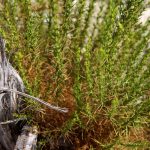 |
Artemisia californica |
California Sagebrush |
California Sagebrush is a member of the sunflower family. Its stems are slender and flexible with pinnately divided leaves that have a length of 1-10 centimeters. They are hairy and normally light green to gray in color. The leaf’s edges are curled under and the plant, when in shrub form, is 15 to 25 decimeters, rounded, and the branches come from the base. |
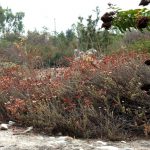 |
Eriogonium fasciculatum |
California Buckwheat |
California Buckwheat is a member of the buckwheat family. Its leaves are cauline and cluster at the end of each stem. The flowers are white or pinkish in color and 2.5-3 millimeters. It yields a flower smooth in texture, and when in shrub form, is 10 to 200 centimeters in height and 50 to 300 centimeters in diameter. |
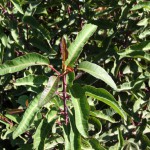 |
Malosoma (Rhus) lauriana |
Laurel Sumac |
Laurel Sumac is a member of the sumac family. It is a small shrub-like tree that is normally 2 to 6 meters in height. The leaves are evergreen with a pointed tip that are folded along the midrib. The branches are slender in bud and have bisexual or unisexual flowers with white petals. |
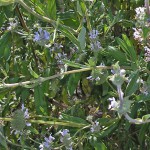 |
Salvia melifera |
Black Sage |
Black Sage, part of the mint family, has wide, tiered clusters of leaves whose upper surface is smooth and whose bottom surface is hairy. The flowers are normally lavender, pale blue or pale rose colored, with a 2-lobed upper lip. This is a perennial shrub that yields small brown fruit in nutlets and is approximately 1-2 meters in height. |
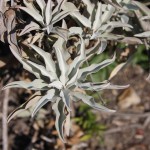 |
Salvia apiana |
White Sage |
White Sage, also part of the mint family, is a subshrub that reaches 1.3 to 1.5 meters in height and 1.3 meters wide. The whitish evergreen leaves have oils and resins that release a strong aroma when rubbed. The flowers are very attractive to bees and have exerted stamens. Several 1 to 1.3 meter flower stalks, sometimes pinkish colored, grow above the foliage in the spring. Flowers are white to pale lavender. |
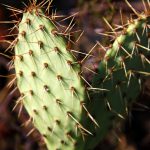 |
Opuntia littoralis |
Beavertail Cactus |
Beavertail Cactus, part of the cactus family, is a small to medium-sized prickly pear cactus that grows to about 60 centimeters tall. A single plant may consist of hundreds of fleshy flattened pads. Depending on the variety, these are blue-gray to green, growing to a length of 14 centimeters and are at maximum 10 centimeters wide and 1 to 1.5 centimeters thick. They are typically spineless but have instead many small barbed bristles called “glochids” that easily penetrate the skin. The pink or purple flowers, rarely white, bloom from spring to early summer. |
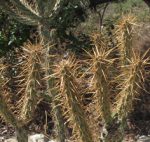 |
Opuntia parryi v. serpentina |
Serpent Cholla |
Serpent Cholla is part of the Cactus Family and has cylindrical or tube-like stems that have clusters of leathery to dry spines that stick out in varying directions. The cactus yields flowers whose outer components are yellow to yellow-green with purple on the inner perianth (including sepals and petals.) The filaments are light green. When fully grown and erect, the cactus can occupy up to three square meters. |
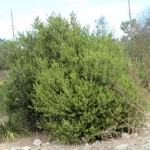 |
Rhus integrifolia |
Lemonade Berry |
Lemonade Berry, part of the sumac family, can take a shrub or small tree form that’s normally 1-8 meters. Its leaves are shiny, wide and elliptical, come to a point and are leathery with branches stout in bud. Lemonade Berry yields bunches of reddish, hairy berries, has flowers with green sepals and white to pinkish petals. |
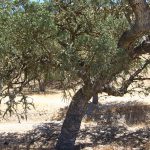 |
Quercus agrifolia |
Coastal Live Oak |
The Coastal Live Oak, part of the beech family, has a trunk with a diameter of 3 -4 meters (when full grown,) with dark green, oval leaves. The margin of the leaf is spiny toothed, and the outer layers of leaves are designed for maximum solar absorption with layers of photosynthetic cells. This oak produces both male and female flowers; the male flowers are overhanging catkins 5-10 centimeters long, the female flowers inconspicuous, less than 0.5 cm long, with 1-3 clustered together. The fruit is a slender reddish brown acorn 2-3.5 cm long and 1-1.5 cm broad. |
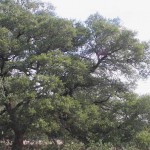 |
Quercus engelmannii |
Engelmann Oak |
The Engelmann Oak can grow up to 10 meters high, is generally evergreen, and has a rounded canopy. The bark is thick, furrowed, and light gray-brown. The leaves are leathery, 3-6 centimeters long and 1-2 centimeters broad, of a blue-green color, and may be flat or wavy, with smooth margins. The flowers are catkins; the fruit is an acorn 1.5-2.5 centimeters long, maturing 6-8 months after pollination. |
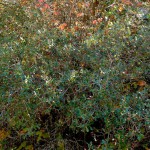 |
Quercus berberidifolia |
Scrub Oak |
Also part of the Oak Family, the Scrub Oak grows to 1-2 meters tall and has sharply toothed, dull green leaves that are 1.5-3 centimeters long and 1-2 centimeters broad, leathery on their top surfaces and somewhat hairy underneath. The solitary or paired brown acorns are 1-3 centimeters long and 1-2 centimeters broad, and pointed or egg-shaped with thin caps when mature; they mature in about 6-8 months after pollination. In cooler, more exposed areas, Scrub Oak is usually a small, compact shrub, but in warm or sheltered areas the plant can spread out and grow several meters high. |
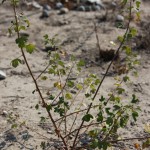 |
Ribes aureum |
Currant |
This shrub is part of the Currant Family and stands 1-3 meters tall, is spineless, and has numerous erect- arching branches forming an irregular crown up to 6 meters tall or more. The shrub is gray to red-brown and has light green, glossy leaves that alternate or cluster. The Currant has small berries that change color by season and alternate red, yellow and orange. |
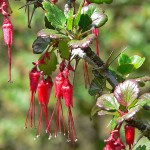 |
Ribes speciosum |
Fuchsia Flowered Gooseberry |
Part of the Gooseberry Family, this shrub stands 2 meters tall and exhibits clustered leaves on short branchlets. The leaves are deciduous, and are generally thin, containing 3 – 5 lobes. A bisexual flower that has 5 petals and is rounded at the tip appears throughout the shrub. Berries are present throughout as well. |
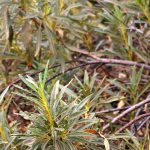 |
Eriodictyon californicum |
Yerba Santa |
A member of the Waterleaf Family, Yerba Santa is a low-growing shrub who range from 2-6 feet in height, depending on elevation. Its stems are bark-shredding and erect. The leaves of Yerba Santa are simple and leathery with a shiny quality, have a balsamic taste and are generally aromatic on warm days. The flower can be white, lavender or purple, and are bell-shaped. The flowers are generally hairy. The fruit of the plant is 1-3 millimeters wide. |
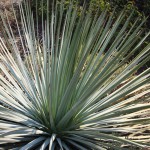 |
Hesperoyucca whipplei |
Our Lord’s Candle |
Our Lord’s Candle, part of the Lily Family, is a species of flowering plant closely related to the Yucca Family. Therefore, the plant dies after it fruits and takes approximately 5 years to reach that point. It produces a stemless cluster of long, rigid leaves which end in a sharp point and yields flowers that are white and generally purple-tipped and appear all over the plant. It is a low growing and the stems stay close to the ground. |
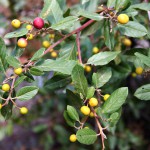 |
Heteromeles arbutifolia |
Toyon |
The Toyon is an evergreen shrub to small tree that grows 2-3 meters high and grows in a rounded, irregular shape. It contains many stems and exhibits white flowers in the summer and red berries in the winter. Its leaves are evergreen, alternate, sharply toothed, have short petioles, and are 5-10 centimeters in length and 2-4 centimeters wide. |
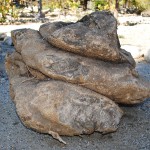 |
Marah fabaceous |
Man in the Ground |
“Man in the Ground” is part of the Marah Family. It exists exclusively in California. It is a perennial vine or herb. The stems are generally climbing with simple, veined leaves throughout. The hairs of this cucumber are generally hardened by calcium deposits. The fruit of the plant is melon-like. Although there are no official documents stating a relationship between the California Legless Lizard and this type of marah, they have been found close together when excavated. |
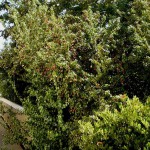 |
Prunus ilicifolia |
Holly-leafed Cherry |
The Holly-leafed Cherry can be either an evergreen shrub or a tree no taller than 15 meters. The leaves are evergreen and are thick, alternating with leaves 1-2 inches in length and looks similar to traditional holly. Many white flowers appear throughout the plant. The fruit is 12-25 millimeters and are spheric. They are red to blue-black in color and are fleshy and edible. |
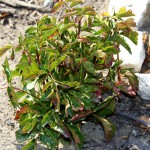 |
Toxicodendron diversilobium |
Poison Oak |
Poison Oak, part of the Sumac Family, is a shrub, tree or vine. It contains many toothed, thin, leathery leaves. The leaves are generally green with red blotches. The fruit is spheric and is cream to brown in color. It is a toxic plant with resin on the leaves, stems and fruits. It can cause severe dermatitis. |
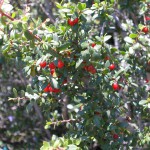 |
Rhamnus crocea |
Spring Red Berry |
The Spring Red Berry, part of the Buckthorn Family, is an evergreen shrub growing 3 – 4 meters high. It contains small red berries throughout the plant. The leaves are simple and generally clustered. The stems are often thorny. |
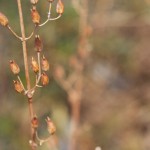 |
Penstemon spectabilis |
Royal Penstemon |
The Royal Penstemon is perennial that measures 1 meter in height. Violet colors appear throughout. The leaves are evergreen and toothed and pointed at the end. |